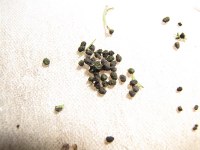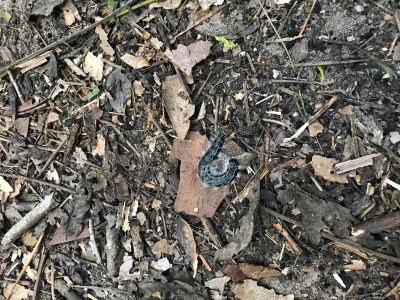Frassfall
October 2013
By Ranger Amy
I was about half a mile into the woods on the Whitetail Trail. As I walked, I repeated my morning mantra, “Come back, come back, come back…to this moment.”
It was a quiet, sunny fall morning. I walked slowly, repeating my mantra, returning to the present moment, and embracing the natural world around me.
I paused, listening to what sounded like tiny raindrops. They hit the leaves above me and fell softly, tap, tap, tap, tap, onto the dusty trail. I closed my eyes and took a moment to savor the sound.
Occam’s Razor problem-solving principle states that the simplest explanation is usually the best one. If you hear raindrops, it’s most likely raining. Don’t assume there’s a person in a cherry picker sprinkling Nerd’s candy.
I knew that what I was experiencing wasn’t rain and it wasn’t candy. It was caterpillar frass, otherwise known as caterpillar poop.
Very hungry caterpillars
 Depending on the size of the caterpillar it can be as large as a pea or as small as the period at the end of this sentence. Some frass are tiny brown sprinkles. Others are surprisingly symmetrical, resembling a sea urchin.
Depending on the size of the caterpillar it can be as large as a pea or as small as the period at the end of this sentence. Some frass are tiny brown sprinkles. Others are surprisingly symmetrical, resembling a sea urchin.
Here I was in the woods, eyes closed, crouching along a section of trail scattered with frass. Knowing what it was didn’t ruin the wonder of the sound that the frass made as it hit leaf after leaf until it found its way to the forest floor.
 I could imagine thousands of serene caterpillars at the top of the tree, filling their bellies with food alongside their family, living in the moment, basking in the sun, serene, peaceful.
I could imagine thousands of serene caterpillars at the top of the tree, filling their bellies with food alongside their family, living in the moment, basking in the sun, serene, peaceful.
Before I stepped out of the “rainfall” or “frassfall”, I snapped a picture of a caterpillar that had fallen. Once I was in the clear, I shook the frass out of my hair and looked up to see what tree they were eating.
Walnut caterpillar
 It was a black walnut tree, and the caterpillar is a walnut caterpillar. These caterpillars eat the leaves of walnut, hickory, oak, willow, honey locust, and pecan trees. They stay together as a colony until they get big.
It was a black walnut tree, and the caterpillar is a walnut caterpillar. These caterpillars eat the leaves of walnut, hickory, oak, willow, honey locust, and pecan trees. They stay together as a colony until they get big.
Once the caterpillars are big, they crawl to the treetop and feed until it’s time to pupate in the soil. They have many natural predators and normally won’t feed on the same tree year after year. The damage they cause is temporary.
They have a cyclical relationship to these trees that dates back countless generations. Trust that they won’t harm the trees. They need the trees, and perhaps the trees need them.
Nature’s mysteries
Nature still has many mysteries. Nature helps heal our hurts and our restlessness. I was walking to stay grounded in the present moment when something as simple as frass brought me back.
Today’s lesson: Cherish every moment, even the frassfall.
